Unusual Flower Types & Photos
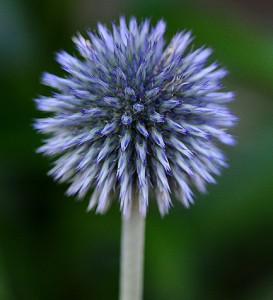 Globe Thistle |
Globe Thistle (Echinops ritro)
Globe Thistle is a clump-forming herbaceous perennial with coarse, prickly leaves with 1-2 ball-shaped silvery-lavender-blue or dark blue flowerheads blooming in early to late summer on rigid branching stems 24-48 inches tall. These beautiful ornamentals grow best in full sun to mostly sunny areas and attract bees and butterflies. In the garden, they will tolerate heat and are deer-resistant. They make excellent cut flowers as well as great additions to dried bouquets.
This flower IS available from your local florist*.
 Allium Bulgaricum |
Allium Bulgaricum (Nectaroscordum siculum)
This ornamental allium is easy to grow, deer-resistant, and hardy to zone 4. They thrive in sunlight and bloom in May and June. Also known as Mediterranean Bells, Sicilian Honey Lily, Ornamental Onion and Sicilian Garlic, they are native to the Mediterranean. The individual florettes begin in an upright position and gradually relax to a cluster of tricolored bells and begin to drape like a floral chandelier. They make an interesting addition to flower arrangements.
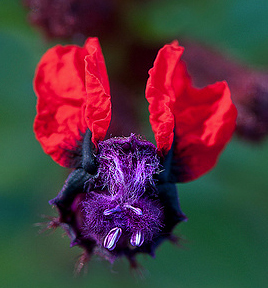 Bat Face Cuphea |
Bat Face Cuphea (Cuphea llavea)
Also known as St. Peter’s plant, Tiny Mice and Bunny Ears, Bat Face Cuphea is a tender tropical evergreen perennial native to Mexico. Bat Face Cuphea prefer partial to full sun and its distinctive red and purple flowers blooms from March through October. Attractive to hummingbirds and bees, the plant is low maintenance, drought-tolerant and makes a great plant for pots, planters, and beds. The plants will grow 2-3 feet tall by 3 feet wide. In early summer, pinch growth off to encourage branching.
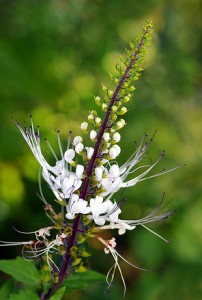 Cat’s Whiskers |
Cat’s Whiskers (Orthosiphon stamineus)
Part of the mint family, Cat’s Whiskers are herbaceous perennial flowering plants originating in tropical East Asia. They grow up to two feel tall and three to four feet wide. The flowers have an orchid-like appearance and are white or lavender, sprouting long stamens that resemble cat’s whiskers. They attract butterflies and hummingbirds and can be harvested to use in herbal teas.
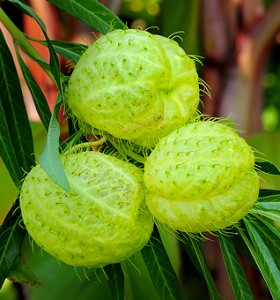 Family Jewels Milkweed |
Family Jewels Milkweed Tree (Asclepias physocarpa)
This species of milkweed is also known as White Butterfly Weed or Swan Plant. Native to Jamaica and South America, this perennial herb can grow to over six feet and prefers full sun and well-drained soil. It is a food source for caterpillars and is a food and habitat plant for the Monarch Butterfly. The small flowers are creamy white and orchid-like, followed by translucent, inflated 2″ green balls covered with soft bristles that are the resulting seedpods. It is a fast-growing tender perennial and grows best in Zones 7-10.
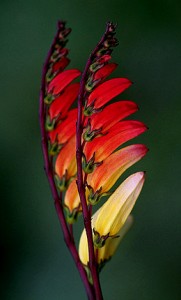 Spanish Flag |
Firecracker Vine or Spanish Flag (Mina lobata)
A tender perennial grown as an annual, this fast climber can grow 10 to 20 feet tall. The incredibly intense-colored 1.5″ blooms are reddish-orange fading to orange yellow and white flowers from mid-summer to fall. Two cultivars include Citronella (cream flowers and red buds) and Mexican Fiesta (red and yellow flowers). A member of the morning glory family, Spanish Flag can be grown in sun to partial shade and is best grown on a lattice.
 Hot Poker |
Red or Yellow Hot Poker (Kniphofia)
Red Hot Poker (Kniphofia uvaria) and Yellow Hot Poker plants are grown from bulbs, and are heat and drought tolerant. They can grow 36″ tall. This variety is ‘Sally’s Comet’ Yellow Hot Poker. Native to Africa, they are known as Torch Lilies. Upright, rocket-shaped blooms produce ample nectar during blooming and are hummingbird magnets. They must be grown in full sun and require good drainage to prevent crown rot. They may spread up to three feet wide. Hardy to zones 5-10.
This flower IS available from your local florist*.
 Liatris |
Liatris or Blazing Star (Liatris)
Hardy perennials White Liatris (Liatris spicata ‘Alba’) and Purple Blazing Star Liatris (Liatris spicata purple), are also known as Gayfeather and Button Snakeroot, and are a member of the Aster family. They bloom from the top down, which is unusual with flowering plants. Each spike is comprised of tiny flowers that are a magnet for pollinators. Ranging from 2-4′ tall, they add height to flower beds and are a popular cut flower in summer floral arrangements with a long vase life.
This flower IS available from your local florist*.
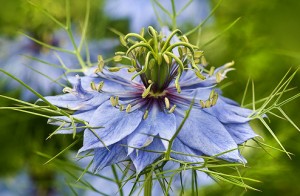 Love-in-a-Mist |
Love-in-a-Mist (Nigella damascena)
Love-in-a-Mist is a beautiful Victorian garden annual blooming in soft shades of blue, pink, white, and lavender. Because its fern-like leaves look similar to fennel, it has also been called fennel flower. This annual herbaceous plant is in the buttercup family (Ranunculaceae), readily self-seeds, and is common in old-fashioned cottage gardens. It grows in full sun to partial shade and blooms from late spring through fall. Nigella is short-lived, so for continuous bloom, repeat sowing every four weeks. You can cut and deadhead this plant to keep it flowering longer.
This flower IS available from your local florist*.
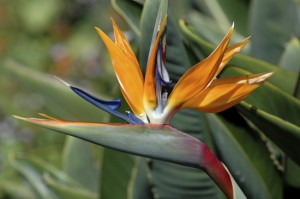 Bird of Paradise |
Bird of Paradise (Strelitzia)
The Bird of Paradise flower is named because of its supposed resemblance of its flowers to the bird of paradise. In South Africa it is commonly known as a crane flower. One of the most colorful and unusual flowers in the world, they bloom from September through May. Although they make beautiful additions to tropical floral bouquets, they can also be grown as a house plant. They require a good amount of sunlight, temperatures above 50 degrees, and regular watering to establish a deep root system. As they mature and have bloomed for a year or two, they can be divided. (Photo from photos.com)
This flower IS available from your local florist*.
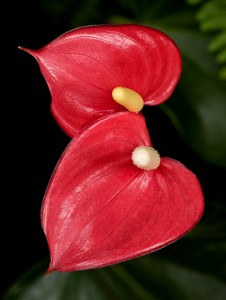 Anthurium |
Anthurium (Araceae)
Also called Flamingo Flower or Flamingo Lily, Anthuriums belong to a large genus of nearly 1,000 species. The flowers are hermaphrodite, containing male and female flowers. The fruits are berries that range from bright red to black, and can also be shaded or bicolored. Anthurium flowers give off a variety of fragrances, each attracting a specific pollinators. Many species of Anthurium are grown as houseplants or outdoors in mild climates in the shade. They make a beautiful addition to any tropical arrangement.
This flower IS available from your local florist*.
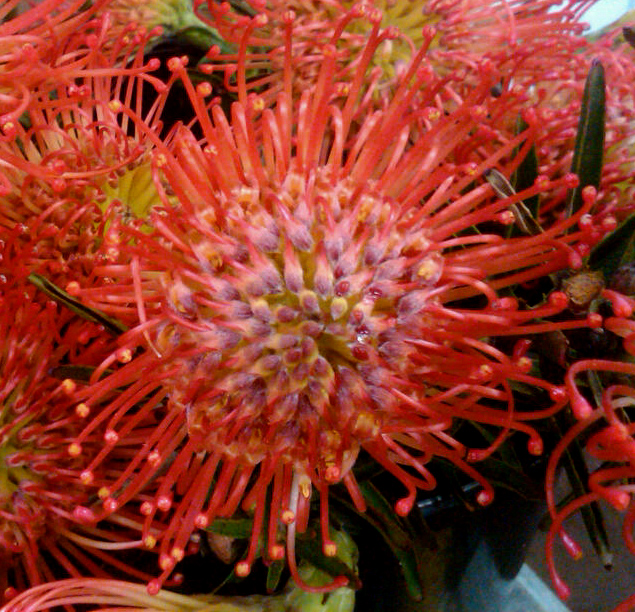 Pincushion Protea |
Pincushion Protea (Leucospermum)
These distinctive flower heads look like a pincushion filled with pins. Native to the cape region of South Africa, these wildly exotic blossoms will add texture to any bouquet. Other genera of the Protea family, which produce beautiful ornamental flowers, are Leucadendron and Leucospermum cordiofolium. Protea make excellent garden plants and provide sturdy, long-stemmed cut flowers. They are very long lasting, too—flowering for 14-21 days in a vase. (Photo from FSN)
This flower IS available from your local florist*.
 Orchids |
Orchids (Orchidaceae)
Orchids are very popular in floral arrangements and there many varieties available. One of my recent favorites is Spathoglottis ‘Golden Passion’, shown at left. Spathoglottis are easy to cultivate and common in tropical gardens. They need sun for part of the day and well-drained loamy soil. The orchids grown by most enthusiasts are the phalaenopsis hybrids (moth orchids) or dendrobium hybrids. The key to success in growing orchids is to mimic the plant’s natural conditions closely. Orchids work beautifully in arrangements as a solo plant or as a focal point among other blooms.
This flower IS available from your local florist*.
So when planning your garden next year, consider adding a quirky and unusual plant (or two) to the mix. Your garden will be anything but ordinary. And the next time you order a floral arrangement, ask your florist to add something with a twist!
*Flowers may not be on-hand. If you would like any of these unusual flowers for your bouquets or arrangements, call ahead to make sure your florists has these special flowers, or has time to special order them.
Cindy Dyer is a graphic designer and photographer in Alexandria, Virginia. Visit her blog at www.cindydyer.wordpress.com and her botanical gallery at www.cindydyer.zenfolio.com. She was recently featured by Nikon in “How to Grow Your Garden Photography Skills” here. She can reached at dyerdesign@aol.com. All photos ©Cindy Dyer, unless specified otherwise.


 Find Your
Find Your 

Speak Your Mind